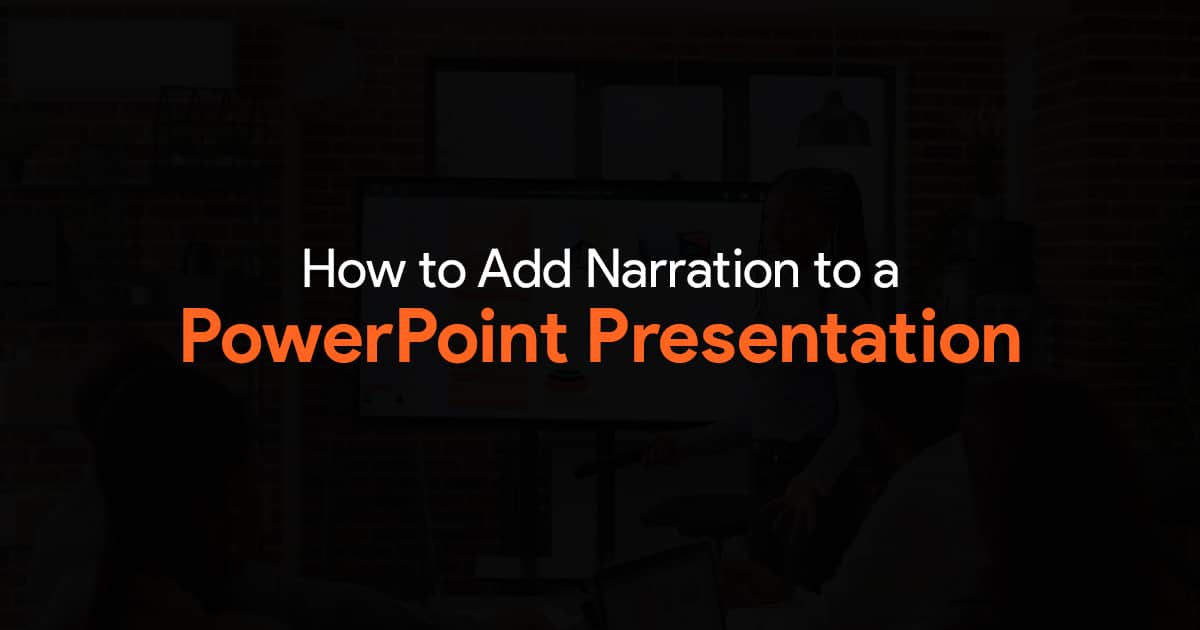- The 2 Different Narration Tools in PowerPoint
- Audio Narration: How to Record Audio on PowerPoint?
- Audio + Video Narration: How to Record SlideShow on PowerPoint?
- How to set the slide timings manually in PowerPoint?
- How to clear your Timings and Narrations?
- How to compress your PowerPoint narrations?
- How to add narration to PowerPoint 2013 – 2019?
How to Add Narration to a PowerPoint Presentation?

A PowerPoint presentation may not be presented in front of an audience in all cases. There are times when the presentation is directly given to a person or a group of people, instead of giving it in front of an audience. It is ideal to give an explanation of the presentation by adding a voiceover narration or even a video narration. If you only want to record the narration for a single slide, you can do that as well. Once you have added the narration, it is like any other presentation – you can either present it in front of an audience or simply save it as a video file.
So, how do you create a narrated PowerPoint presentation? Read on to find it out.
Table of contents
- The 2 Different Narration Tools in PowerPoint
- Get a Quiet Place to Record
- Set up your Microphone (Fancy Equipment Not Required)
- Audio Narration: How to Record Audio on PowerPoint?
- Step 1: Find the Record Sound dialog box
- Step 2: Record the audio
- Step 3: Choose when the audio should play
- Step 4: Delete or overwrite a previous narration file
- Audio + Video Narration: How to Record SlideShow on PowerPoint?
- Step 1: Find the Record Slide Show dialog box
- Step 2: The recording process
- Step 3: Choose when the narration should play
- Step 4: All the features in the Slide Show Record option
- How to clear your Timings and Narrations?
- How to Compress your PowerPoint Narrations?
- How to add narration to PowerPoint 2013 – 2019?
- Conclusion
The 2 Different Narration Tools in PowerPoint
Tool 1 – Record Audio:
The Record Audio tool is a simple and handy tool within PowerPoint that is capable of recording audio with ease. This tool is only capable of voice narration and will only allow recording for one slide at a time.
Tool 2 – Record Slide Show:
The best form of narration on PowerPoint is done using the Record Slide Show tool. It lets you record both audio and video narration at a time. You can even record the complete presentation in one go instead of going slide-by-slide. It also set slide timings automatically. So, it will be useful later when you try to convert PowerPoint into a video.
First things first: get a quiet place to record
The very first step in creating a PowerPoint narration is to find a distraction-free zone. You might use the most advanced noise-canceling microphone, yet a noisy background can distract you. If you are using a normal recording setup, then you will have a hard time recording narration without disturbances. Look around carefully before recording to avoid disturbances from the streets with cars honking, people making noise, noisy air conditioners or refrigerators, or even noise from cell phones, and doorbells.
This may not seem important as you read. But, it is very crucial while you actually record. Imagine being in the middle of a narration and getting interrupted by a colleague. The noise that they made can cause disturbance and them interrupting what you were already doing can distract you.
Set up your microphone (no need of fancy recording gear!)
Yes, you read it right. You don’t need fancy equipment or a studio-like setup to narrate your presentation. You are good to go with the built-in microphone on your computer. In fact, in most cases, you don’t really need any audio recording devices if it’s a simple concept-explaining presentation. However, you can invest in an external microphone only if the presentation is extremely important or if you are creating training materials.
What if your mic wasn’t functioning all along the narration process? You would never want that to happen. So, you need to set up your microphone before starting the narration. Firstly, check if you have plugged in the mic in the first place. If you have done that, test and troubleshoot the audio quality of the mic. You can do this by right-clicking on the speaker icon in the taskbar, clicking on Sound settings, selecting your Input device, and choosing to Troubleshoot under Test and troubleshoot.
Pro tip: If your microphone is still not working, simply connect all audio and video equipment to the computer, and restart it. In most cases, this action fixes the audio issue.
Audio Narration: How to Record Audio on PowerPoint?
Adding audio to a PowerPoint presentation is the most basic form of creating a narration. This tool can be used to simply drop voice notes on your slides even if you don’t plan to add narration to your PowerPoint. In such cases, this becomes a useful feature if you want to immediately capture your thoughts and ideas about a slide without having to write them down.
With that aside, let’s start with the actual step of adding audio to PowerPoint.
Step 1: Find the Record Sound dialog box
Firstly, click on Insert from the PowerPoint ribbon. You will see the Audio dropdown option towards the right side of the screen; click on the dropdown and select Record Audio.
Note that this tool will only let you record audio for one slide at a time.
Step 2: Record the audio
A dialog box pops up after performing the previous action. Start with naming the audio by filling the Audio textbox.
Click on the button with the red dot to Record, use the stop button to Stop, and the play button to Play/Listen to your narration. Finally, hit OK to save the audio.
This action will add a little audio icon over your slide, and you can move it around or resize it as you like. Simply tap on this icon to play the recorded narration/ audio in the normal view or the slide show view of the presentation.
Step 3: Choose when the audio should play
There are multiple ways of playing your audio in a PowerPoint presentation. You can choose how and when the audio should play on a slide. The audio will automatically play if you don’t manually set this. To find these options, click on the audio icon, and navigate to the Playback tab that appears. Next to Start, there will be 3 options – In Click Sequence, Automatically, and When Clicked On.
Here is what these options can do:
In Click Sequence:
This option plays the audio file automatically with a click. It basically plays as part of the click sequence of actions that happen on the slide. The audio plays right before you go to the next slide if there are no other sequences set up on the slide.
Automatically:
This option will play the audio as soon as you get on to the slide, without any click or playing right before you go to the next slide.
When Clicked On:
This option lets the audio play only when someone clicks on the icon during the presentation in the Slide Show mode. So, if you are running out of time while presenting, you can easily skip playing the audio.
Step 4: Delete or overwrite a previous narration file
Suppose you recorded a narration file, but feel that it isn’t up to your expectation, you can straight away remove it using the Delete key on your keyboard. Suppose you want to overwrite the existing narration, go to the Record Audio dialog box again and repeat the recording process. This action will replace the audio. Note that this means you can’t have 2 audio files existing on the same slide.
Audio + Video Narration: How to Record SlideShow on PowerPoint?
The best way to narrate is by coupling audio and video. The Record Slide Show tool does exactly that; you are free to record audio and video together as well as separately. It is the best tool for recording narration on PowerPoint so far. With this tool, you can narrate the entire presentation in one go, unlike the Record Audio tool which would only allow you to go slide-by-slide. Another useful feature is that you can use the pen, highlighter, & laser pointer tools and record it. Besides these features, you can easily pause and restart your recording at any time. The best part is that it automatically records slide timings, thereby helping you create a video out of the presentation.
With that aside, let’s start with using this tool.
Step 1: Find the Record Slide Show dialog box
Start with identifying the Record tool under Slide Show. You will find this when you click on the Slide Show tab from the ribbon, click on the Record tool, and select From Beginning from the dropdown. Note that, the recording will start from the current slide if the Record tool is directly clicked on instead of using the dropdown. After this action, you are ready to start recording your narration.
Step 2: The recording process
The previous action opened a screen where you can work on the narration recording. Before you start, ensure that the microphones and camera are turned on and working well. You can find the Record, Stop and Replay buttons on the top left corner of the screen. As you record, you will want to move to the subsequent slides which can be easily done by using the arrow keys.
Feel free to use the pause button that appears once you start recording. This can be very useful if you want to think, organize your thoughts, and then give them out. Once the recording gets over, the video and/or audio file corresponding to each slide gets added to the lower right-hand corners of each individual slide. This becomes handy when you start reviewing the recording from each slide.
Just like the Record Audio option, the video narration slide per slide can just be one file. So, if you re-record the audio or video, it gets overwritten. But, here’s a pro tip: You can have two narration files on a single slide by recording one with the Record Audio tool and the other with the Record Slide Show tool.
Step 3: Choose when the narration should play
By default, the recorded Slide Show/ narration is set to play Automatically. This means that the recording will play from the beginning or from the current whenever you run the presentation.
You can alter this setting just like the way you did it for the audio. The steps are as follows. Click on the narration file from the slide, click on the Playback tab placed on the right side, click on the dropdown placed against Start, and you will see 3 options to choose from. They are In Click Sequence, Automatically, and When Clicked On. Just like the audio, when the video plays as a part of the click sequence of actions that occur on the slide, the option selected is In Click Sequence. If the narration video plays as soon as you are on the slide or advances to a slide, the option is set as Automatically. Finally, the option is set as When Clicked On if you want the narration to play only when you click on it.
Step 4: All the features in the Slide Show Record option
Here are all the different features from the Slide Show Record option.
- Recording options: There is a Record button to start the recording; you can simply click the letter R on the keyboard otherwise. Click on the letter I on the keyboard to Pause the recording. Use the letter S or click on the Stop button to stop the recording. Remember to use the arrow keys to move to the next slide’s narration instead of using the Stop button. You can also Replay a slide’s narration. It’s just that the button turns active after you record the full narration of the slide.
- Speaker Notes options: This is a useful option while recording since the narrator can keep their notes here and refer to it time-to-time. The best part is that the action of opening and closing the speaker notes pane will not get recorded. This pane is fairly small in size and cannot be resized. However, you can control the font size of the notes. You can either click on Notes or use the letter N from the keyboard.
- Clear Recordings options: You can always click on the cross button to Clear Recordings if you don’t like it. You can choose to remove recordings from the slide you are in or from the complete presentation as well. Just note that this step removes both slide timings and narrations.
- Input options for Camera and Microphone: Right next to the Clear Recordings option, you can find the Input Options. Use the Microphone option to select the microphone you want to record with. Similarly, the Camera option lets you choose the system’s camera or external webcam to record with.
- Advance Slide options: You can click on the arrow button placed on the left and right sides of the slide if you want to advance a slide to the next one or move back to the previous slides. Suppose you have animations or music lined up in the upcoming slides; these would play first and advance to the other slides as you click forward. Also, note that you are not allowed to go to the previous slide if the narration is being recorded. This is simply because the re-recording of a narration overwrites the previous one.
- On/Off – Camera, microphone, and Camera Preview: Below the slide, towards the right side, you will find 3 little icons indicating Microphone, Camera, and Camera Preview. You can click on them to turn them on and off. Camera Preview is useful when you want to stop seeing yourself on the screen being recording during the narration. Also, note that turning the Camera Preview off won’t remove the thumbnail icon of you on the lower right-hand corner of the slide.
- Ink options – Eraser, Pen, and Highlighter: You can write over the slide using a Pen, highlight anything using the Highlighter, and remove it using the Eraser. You can skip going to the bottom bar to click on each of these. Instead, you can use the shortcuts Ctrl + P for the Pen, Ctrl + I for the Highlighter, and Ctrl + E for the Eraser. Using these tools while the recording is on can make the narration interesting.
- Slide Timings options: This section gives you information about how long you have spent on each slide, and on the slide number on which you are right now. This is useful if you want to have a tab on the time taken, especially if you plan on converting the PowerPoint presentation into a video.
- Close / Minimize options: You can exit from the recording setup by clicking on the Close/ Minimize button in the top right corner. Or use the Esc key on your keyboard to exit.
How to set the slide timings manually in PowerPoint?
By default, PowerPoint records the slide timings as you narrate. But, if you want to specifically control the duration each slide consumes, PowerPoint has a way for that too. First, select the slide whose timing needs to be set. Now, head over to the Transitions tab on the ribbon, find the Timing group placed toward the right side, and tick on the After checkbox under Advance Slide. Enter the number of seconds you want the slide to appear on the box placed next to it.
Further, tick on the On Mouse Click check box too if you want the next slide to appear via your manual click or automatically after the number of seconds gets over.
Slide timings get useful in a lot of instances. One such case is when you have an unnecessary narration or audio at the end of a slide, you can skip it from playing by setting the time for advancing to the next slide a little bit early.
How to clear your Timings and Narrations?
You can clear both Timings and Narrations from the Normal View of PowerPoint by following these steps. Head over to the PowerPoint ribbon, click on the Slide Show tab and open the Record dropdown. You will find the Clear option below the 2 recording options. Further, it will let you choose 4 options – Clear Timing on Current Slide, Clear Timings on All Slides, Clear Narration on Current Slides, and Clear Narration on All Slides. Just as they say in simple English, there are options to remove timing from an individual slide as well as from the complete presentation. Similarly, the narration can be cleared from an individual slide as well as from the complete presentation.
How to compress your PowerPoint narrations?
Once you are done with the recordings, the narrated PowerPoint is going to have an enormous size. So, the best way to go about is to compress the PowerPoint presentation after adding these narrations. This way, it would be convenient for you to share it with someone. Here’s how you compress PowerPoint. Go to your Files tab, select Info, click on the Compress Media drop-down, and finally choose the compression quality of your preference (1080p, 720p, or 480p). By default, PowerPoint records audio and video in Full HD (1080p). In such cases, you need to go for either the HD (720p) or Standard (480p) options if you can’t afford to manage storage space.
To know more about compressing your PowerPoint files, check out this article.
How to add narration to PowerPoint 2013 – 2019?
Not everyone would be using the latest version of Microsoft PowerPoint. So the steps mentioned above might not be handy for those people. Here are the detailed steps to narrate a PowerPoint presentation with versions from 2013 to 2019.
- Start with opening your presentation, go to the Slide Show tab, and click on Record Slide Show. You can click on the upper half of the button to start from the current slide. You get an option to start from the beginning or from the current slide upon clicking the lower half of the button.
- You will be able to see the Clear option grayed out if there is no previous recording. Be careful around this option since accidentally clicking can erase all your narrations and/or timings.
- The Record Slide Show pop-up box that appears after the previous step will have two checkboxes, which will be mentioned in detail below. You can tick or untick them and hit the Start Recording button.
Checkbox 1 – Slide and animation timings:
Tick on this checkbox if you want PowerPoint to record the time you spend on each slide which can include the use of any action triggers and animation playing.
Checkbox 2 – Narrations, ink, and laser pointer:
Ticking on this checkbox lets you record your voice as you advance through the presentation. It also records the use of tools like the pen, highlighter, eraser, and laser pointer.
Quick note:
For PowerPoint 2013, February 16, 2015 update, and beyond, the pen, highlighter, and eraser recording are available. For all the versions before it, the pen and highlighter strokes are saved as ink annotation shapes.
- You can use the buttons that indicate to go to the next slide, pause the recording, and re-record the current slide from the Recording toolbar on the top left corner of the window.
- Note that re-recording on PowerPoint erases your previously recorded narration which can include audio, ink, and laser pointer. You can re-record by simply starting the recording again on the same slide.
- Tools like Laser Pointer, Pen, Highlighter, and Eraser can be selected by right-clicking the slide and selecting the Pointer options. Also, use Ink Color to change the color of the ink.
- Right-clicking on the final slide and clicking End Show ends the recording.
- You will be able to see a sound icon appears in the lower-right corner of each slide at the end of the narration. Not just that, the timings of the recordings will be automatically saved and you can view them from the Slide Sorter view just beneath each slide.
- You can find all narration files embedded in each slide, which can be played in Slide Show just like animations, inking actions, laser pointers, etc. The audio narration can be previewed from the Normal view by clicking on the sound icon in the lower-right corner of the slide and clicking the Play button.
- Although PowerPoint automatically records slide timings, you can manually change the timings for each slide. Head over to the Transitions tab, find Advance Slide under the Timing group, and select the After check box, to enter the number of seconds the slide should appear.
- Use the Clear option to remove timings or narration from a slide. Here are the 4 clear options you will see (which are all self-explanatory):
Delete the timings on the currently selected slide
Delete the timings on all slides at once
Delete the narration on the currently selected slide
Delete the narration on all slides at once - After recording, the narration and timings that appear along with the slide can be turned off if you want. Simply use the Use Timings box on the Slide Show tab to turn off recorded slide timings and clear the Play Narrations box to turn off recorded narrations, ink, and the laser pointer.
Conclusion
Start recording narration before sharing your PowerPoint presentation with someone. Make it a little easy and interesting for them. Moreover, pour in your creativity through narrations and help people better understand what you want to convey. We hope this article was helpful.


